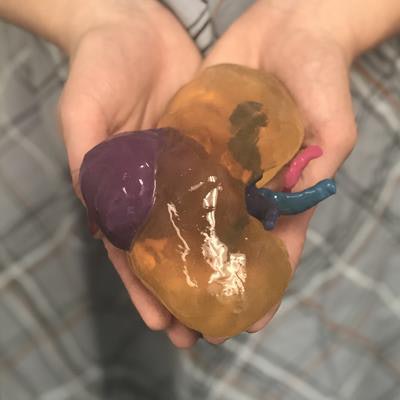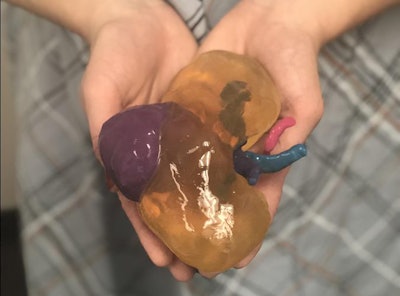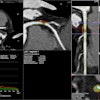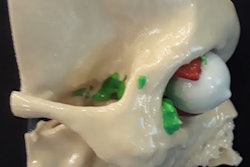
CHICAGO - Researchers from New York have created hundreds of individually tailored kidney and prostate cancer models using 3D printing and augmented reality (AR) technologies. The 3D models have helped improve patients' understanding of their disease and treatment, according to a presentation at RSNA 2018.
When provided to patients during consultations, 3D-printed and AR models could help them better understand the specific details of their kidney or prostate tumor and feel more secure in their surgical treatment options, presenter Nicole Wake, PhD, from NYU Langone Health told session attendees.
"Overall, we think all types of the 3D models were helpful in regards to learning about the anatomy, disease, cancer location, and treatment plan," she said. "It's much more powerful to see a physical model than to have the patient go through images with the surgeon, where it's hard to describe what the organ actually looks like in terms of its shape and size."
3D urologic cancer models
Surgical removal of prostate cancer comes with a high risk of morbidity, including possible erectile dysfunction and urinary incontinence, and kidney tumor surgeries have been associated with long operating times and considerable blood loss, Wake noted. The complexity of these surgeries often makes it difficult for physicians to adequately explain the condition and treatment plan to patients using conventional 2D images.
To improve upon existing patient consultation methods, Wake and colleagues conducted a prospective study assessing the value of using 3D-printed and AR models for 200 patients with kidney or prostate cancer. All of the patients underwent an MRI or CT exam between March 2017 and July 2018 and were scheduled to undergo surgical treatment.
 3D-printed kidney with color-coded structures, including tumor (purple), arteries (pink), veins (light blue), and the collecting duct system (dark blue). Image courtesy of Nicole Wake, PhD.
3D-printed kidney with color-coded structures, including tumor (purple), arteries (pink), veins (light blue), and the collecting duct system (dark blue). Image courtesy of Nicole Wake, PhD.To build the models, the researchers followed a general workflow for 3D modeling: First, they acquired standard MRI or CT scans, and they segmented select anatomy from the scans for the generation of 3D virtual models using computer software (Mimics, Materialise). Next, they created the models with a 3D printer (Objet J750, Stratasys), and finally, they postprocessed the models with dry sandpaper and polyurethane coating.
For the AR models, they converted the file format of the 3D virtual models from stereolithography (STL) to OBJ and then programmed them into AR-compatible models using gaming software (Unity, Unity Technologies).
The group presented either a 3D-printed model or an AR model of the kidney or prostate to the corresponding patient during presurgical consultation. Following the consult, all patients completed a survey that gauged their subjective understanding of details regarding their cancer and the reasoning behind the proposed treatment plan, as well as their confidence in the surgical plan.
The patients also rated the extent to which the various kinds of imaging helped them learn about their anatomy, disease, and surgery, along with the potential complications associated with the procedure, on a scale of 1 to 10.
Helpful for patients
After examining the patients' responses, Wake and colleagues discovered that the realistic and intuitive visualization provided by the 3D-printed and AR models improved the patient education process substantially.
On average, the patients who had access to 3D-printed models scored their understanding of the cancer, tumor size and location, and surgery as a 4.7 or 4.8 on a five-point Likert scale, for which a 5 indicated very good understanding. This was a statistically significant improvement compared with 2D imaging.
The patients also claimed that the 3D-printed models helped them learn about their basic kidney or prostate anatomy (9.2/10), type of tumor (9.1/10), necessary surgical treatment (8.9/10), and potential complications (8.4/10) more effectively than 2D imaging or 3D virtual models did.
In contrast, the AR models, though reported to be valuable by the patients, did not increase their understanding or learning any more than they achieved by examining the 2D images.
The comprehension of size and scale was too difficult to replicate on 3D computer or AR models, especially because the users were able to alter the size of the virtual models, Wake noted. As a result, the 3D-printed models were more helpful than any of the other models.
"As compared to traditional imaging or other methods of advanced imaging visualization, such as 3D computer models or AR, we believe that 3D-printed anatomical models allow for enhanced insight into the underlying anatomy since they provide both spatial comprehension and tactile feedback."



















